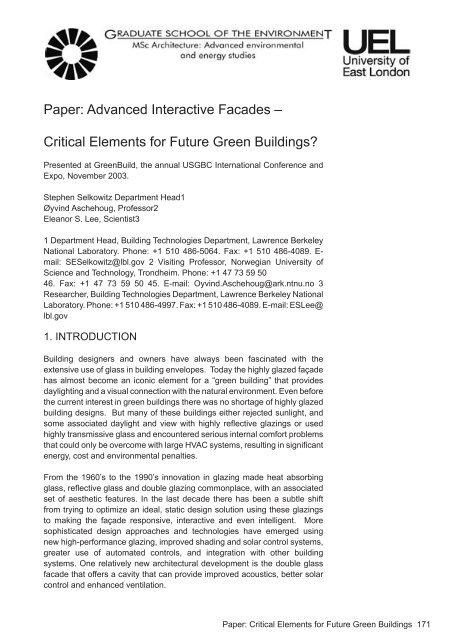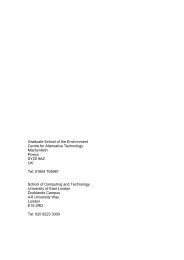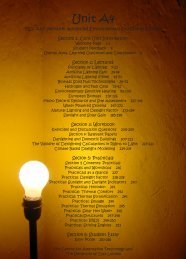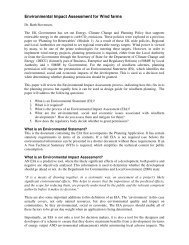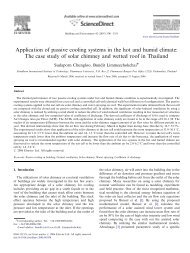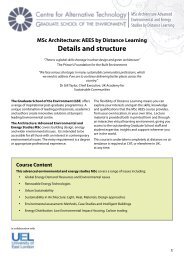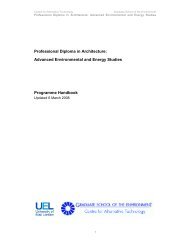Module B1 Study Book - the Graduate School of the Environment
Module B1 Study Book - the Graduate School of the Environment
Module B1 Study Book - the Graduate School of the Environment
Create successful ePaper yourself
Turn your PDF publications into a flip-book with our unique Google optimized e-Paper software.
Paper: Advanced Interactive Facades –<br />
Critical Elements for Future Green Buildings?<br />
Presented at GreenBuild, <strong>the</strong> annual USGBC International Conference and<br />
Expo, November 2003.<br />
Stephen Selkowitz Department Head1<br />
Øyvind Aschehoug, Pr<strong>of</strong>essor2<br />
Eleanor S. Lee, Scientist3<br />
1 Department Head, Building Technologies Department, Lawrence Berkeley<br />
National Laboratory. Phone: +1 510 486-5064. Fax: +1 510 486-4089. E-<br />
mail: SESelkowitz@lbl.gov 2 Visiting Pr<strong>of</strong>essor, Norwegian University <strong>of</strong><br />
Science and Technology, Trondheim. Phone: +1 47 73 59 50<br />
46. Fax: +1 47 73 59 50 45. E-mail: Oyvind.Aschehoug@ark.ntnu.no 3<br />
Researcher, Building Technologies Department, Lawrence Berkeley National<br />
Laboratory. Phone: +1 510 486-4997. Fax: +1 510 486-4089. E-mail: ESLee@<br />
lbl.gov<br />
1. INTRODUCTION<br />
Building designers and owners have always been fascinated with <strong>the</strong><br />
extensive use <strong>of</strong> glass in building envelopes. Today <strong>the</strong> highly glazed façade<br />
has almost become an iconic element for a “green building” that provides<br />
daylighting and a visual connection with <strong>the</strong> natural environment. Even before<br />
<strong>the</strong> current interest in green buildings <strong>the</strong>re was no shortage <strong>of</strong> highly glazed<br />
building designs. But many <strong>of</strong> <strong>the</strong>se buildings ei<strong>the</strong>r rejected sunlight, and<br />
some associated daylight and view with highly reflective glazings or used<br />
highly transmissive glass and encountered serious internal comfort problems<br />
that could only be overcome with large HVAC systems, resulting in significant<br />
energy, cost and environmental penalties.<br />
From <strong>the</strong> 1960’s to <strong>the</strong> 1990’s innovation in glazing made heat absorbing<br />
glass, reflective glass and double glazing commonplace, with an associated<br />
set <strong>of</strong> aes<strong>the</strong>tic features. In <strong>the</strong> last decade <strong>the</strong>re has been a subtle shift<br />
from trying to optimize an ideal, static design solution using <strong>the</strong>se glazings<br />
to making <strong>the</strong> façade responsive, interactive and even intelligent. More<br />
sophisticated design approaches and technologies have emerged using<br />
new high-performance glazing, improved shading and solar control systems,<br />
greater use <strong>of</strong> automated controls, and integration with o<strong>the</strong>r building<br />
systems. One relatively new architectural development is <strong>the</strong> double glass<br />
facade that <strong>of</strong>fers a cavity that can provide improved acoustics, better solar<br />
control and enhanced ventilation.<br />
Paper: Critical Elements for Future Green Buildings 171


